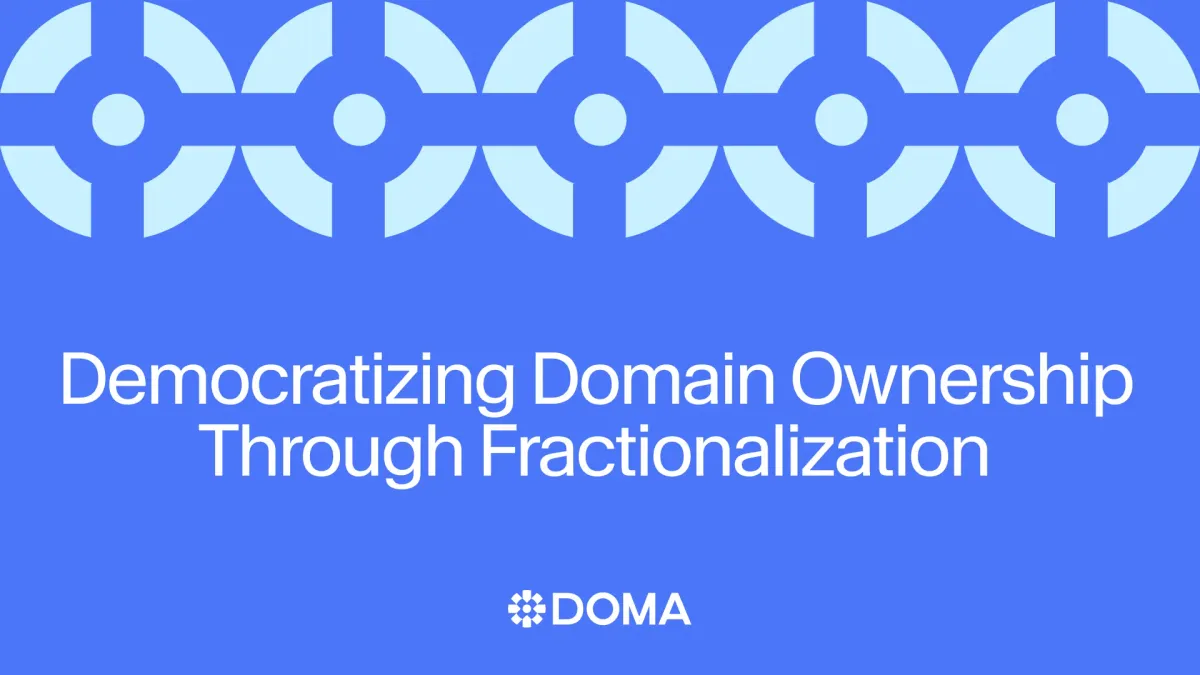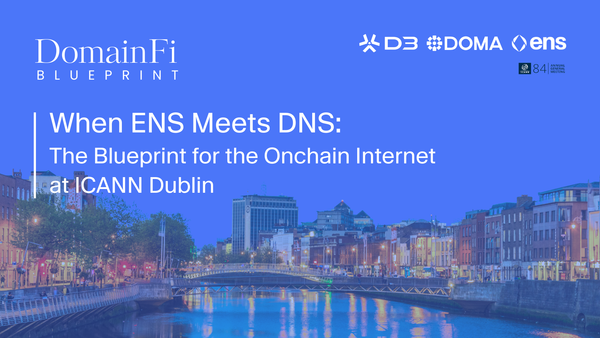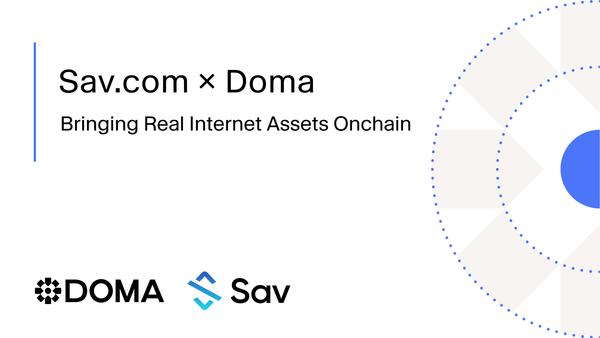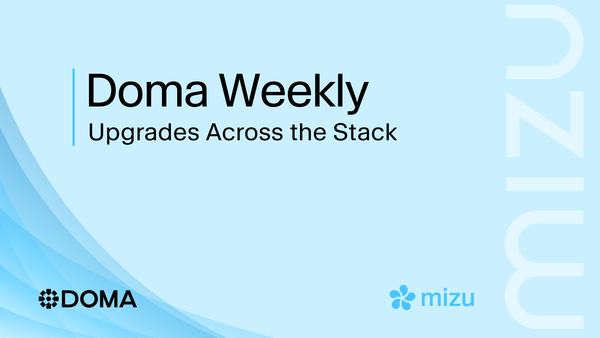Democratizing Domain Ownership through Fractionalization

Fractionalization is one of the most powerful features of the Doma Protocol. Premium domain names are some of the most valuable digital assets in the world. Traditionally, only whales could afford the top-tier names.
With Doma, that’s changing.
We’re entering a new era of ownership, one that is more inclusive, more programmable, and more liquid. At the heart of this shift is fractionalization.
But here’s the thing: fractionalization isn’t a one-size-fits-all solution. There are many approaches, each with its own trade-offs and ideal use cases.
Let’s explore why fractionalization matters, how different types of investors think about it, and what a flexible architecture should solve for.
Why Fractionalization?
Let’s keep it simple.
Tokenization is the process of turning ownership of an asset into a digital non fungible token (NFT) on the blockchain. Fractionalization is the act of making this asset fungible,allowing multiple parties to claim verifiable ownership of the fractions of the same asset.
Together, tokenization and fractionalization make high-value assets more accessible, more liquid, and easier to use in decentralized markets.
Doma’s fractionalization module makes it possible for anyone to own a piece of a premium domain. Instead of needing to buy an entire domain, you can own a fraction of it through digital tokens on a blockchain.
With this model, an owner could:
- Convert their domain into tokens.
- Sell a portion of the tokens for ready liquidity.
- Keep the rest for future upside
Key Benefits of Fractionalization
- Increased Liquidity: Assets like domains and real-estate are notorious for their low liquidity. By converting assets into tokens, they become easier to trade, since it allows investors to buy and sell fractional segments of the asset.
- Democratizing Access: Fractionalization lowers the barriers to entry. Anyone with an internet connection can now lend, borrow, split up, trade, and send tokenized assets nearly instantly anywhere in the world, any time, for a low cost via blockchains.
- Expanded Utility: Fungible tokens have a much larger expanded use case pool in DeFi, including easier collateralization, yield aggregation, vaults, perps, synthetics, governance, staking etc.
- Cost Effective: Leveraging blockchain technology and smart contracts means the costs involved in buying and selling assets can be greatly reduced. Plus, in many cases, it removes the need for intermediaries, directly connecting buyers and sellers.
- Portfolio Diversification: A diversified portfolio is a powerful portfolio, and with fractionalization, the sheer amount of asset classes you could invest in increases dramatically. Imagine sitting in Sri Lanka and investing in a beach house in Hawaii! You can also invest in a host of other assets which were previously locked away from you or were simply too illiquid to trade.
- Transparency: In regions with low trust in institutions or record-keeping, blockchain offers radical transparency. Ownership, transfers, and transactions are all recorded immutably, reducing fraud, corruption, and clerical errors.
What’s Fueling the Fractional Investment Boom?
Several factors have fueled the growth of fractional investments:
- Tech Savviness: The rise of sophisticated FinTech platforms and blockchain technology has allowed developers to easily fractionalize assets and manage ownership.
- Changing Investor Behavior: Younger investors prefer diversified portfolios and are comfortable enough with tech to invest in newer asset classes.
- Regulatory Support: Governments and regulatory bodies are increasingly warming up to tokenization and encouraging developments in this sector.
Why Fractionalization Matters for Domains
Unlike physical assets or financial instruments, domains are digital-native, globally liquid, and often strategic. That means people come to fractionalization with very different motivations. Here are just a few examples of what investors might want:
- Mass, On-Chain Ownership: Communities might want to co-own a domain in a fully on-chain, transparent way, with verifiable provenance and collective governance.
- Semi-Liquid Holdings: An owner might want to list 30% of a domain’s value to gauge market interest, but retain majority control and exit flexibility.
- Opportunistic Liquidation: Projects or treasuries may want a fast path to unlock liquidity, fractionalize now, and let the market price the asset over time.
- Controlled Sale Mechanics: Founders may want to retain veto rights over domain sales, even while distributing fractional ownership to supporters or investors.
One Model Doesn’t Fit All
As has been made evident in the previous section, not every domain investor wants the same thing from fractionalization. Some want a full exit, others want partial liquidity. Some want governance, others want none.
That’s why rigid models don’t work.
A well-architected fractionalization system shouldn’t force everyone into a single model. It should decouble the protocol layer (aka what’s guaranteed) from the customization layer (aka what’s designed).
The Protocol Layer
A strong protocol should always take care of the core mechanics:
- Custody: Secure, verifiable, on-chain locking of the original domain NFT
- Reconstitution: Unique reconstitution mechanisms that are purpose-built for domains as RWAs
- Unified Liquidity: Cross-chain compatibility, enabling trading across multiple chains and DEXs
- Price Discovery Hooks: Integrated market feeds that allow dynamic, real-time valuation
These are the foundations. Every fractional domain on Doma inherits them by default.
The Customization Layer
This is where domain investors can shape the ownership experience to match their goals. You can customize this section to adjust the following:
- Ownership Distribution: Tokens can be evenly split, tiered by contributor class, or weighted to prioritize founders and early backers.
- Liquidity Model: Domains can be fractionalized at a fixed price, launched with bonding curves, seeded into AMM pools, or sold via dynamic auctions.
- Governance Settings: Token holders may have voting rights, founder veto powers can be preserved, or the structure can eliminate governance entirely for simplicity.
- Token Utility: Fractional tokens can represent pure financial ownership or unlock additional benefits like platform access, user benefits, or protocol rewards.
This clear separation of responsibilities is what gives the Doma approach its strength.
The protocol takes care of the essentials: securing the domain, enabling liquidity, and managing the full lifecycle of ownership. Everything else, from how ownership is structured to how tokens behave, is left open for creators and launchpads to define.
You're equipped with a flexible framework to build the exact experience you need.
Up Next: Fractionalization mechanics and how Doma implements them
In subsequent posts, we’ll go deeper into domain fractionalization scenarios and how Doma enables them through its fractionalization stack, including:
- Ensuring secure, on-chain custody of domain assets
- Enabling flexible reconstitution
- Powering unified liquidity across chains and exchanges
- Supporting novel launchpads and builders to design their own ownership flows on top
As ownership becomes more programmable, domains are evolving from static assets to dynamic instruments. Doma’s fractionalization model lays the foundation for this shift.





